Abstract
At present, lead halide PVSKSCs are promising photovoltaic cells but have some limitations, including their low stability in ambient conditions and the toxicity of lead. Thus, it will be of great significance to explore lead-free perovskite materials as an alternative absorber layer. In recent years, the numerical simulation of perovskite solar cells (PVSKSCs) via the solar cell capacitance simulation (SCAPS) method has attracted the attention of the scientific community. In this work, we adopted SCAPS for the theoretical study of lead (Pb)-free PVSKSCs. A cesium bismuth iodide (CsBi3I10; CBI) perovskite-like material was used as an absorber layer. The thickness of the CBI layer was optimized. In addition, different electron transport layers (ETLs), such as titanium dioxide (TiO2), tin oxide (SnO2), zinc oxide (ZnO), and zinc selenide (ZnSe), and different hole transport layers, such as spiro-OMeTAD (2,2,7,7-tetrakis(N,N-di(4-methoxyphenylamine)-9,9′-spirobifluorene), poly(3-hexylthiophene-2,5-diyl) (P3HT), poly[bis(4-phenyl)(2,4,6-trimethylphenyl)amine (PTAA), and copper oxide (Cu2O), were explored for the simulation of CBI-based PVSKSCs. A device structure of FTO/ETL/CBI/HTL/Au was adopted for simulation studies. The simulation studies showed the improved photovoltaic performance of CBI-based PVSKSCs using spiro-OMeTAD and TiO2 as the HTL and ETL, respectively. An acceptable PCE of 11.98% with a photocurrent density (Jsc) of 17.360258 mA/cm2, a fill factor (FF) of 67.10%, and an open-circuit voltage (Voc) of 1.0282 V were achieved under the optimized conditions. It is expected that the present study will be beneficial for researchers working towards the development of CBI-based PVSKSCs.
1. Introduction
Energy is a necessity in today’s world, and it is very difficult to survive or even imagine human life without energy. Energy consumption has significantly increased in the last few decades, whereas energy supplies are largely dependent on fossil fuels and conventional energy sources [1,2,3]. Energy generation is of great significance for the next generation of the world due to globalization and the increase in the global population. It is well known that conventional energy sources such as fossil fuels are widely used to fulfill energy requirements [4]. Thus, there is no doubt that fossil fuels are the main energy source, but unfortunately, they are the main contributor to greenhouse gas emissions and play a significant role in global warming [5]. Therefore, they may also further cause various negative impacts on the environment and human health [6]. In addition, these conventional resources are limited, and the depletion of fossil fuels is another challenge [6]. The energy demand is continuously increasing, which may also cause a global energy crisis in the next few decades. Therefore, the development of green, clean, and neat energy is a desirable task in the modern world. There is no doubt that previous years have witnessed significant progress in the development of various energy technologies, including those for energy storage, energy conversion, batteries, hydrogen production, and fuel cells [7,8,9,10]. Still, the commercialization of energy technologies should benefit the world in terms of cost-effectiveness and environmental friendliness. In this regard, it can be clearly understood that solar energy, which is a green energy source, is a never-ending renewable energy source, and it can be utilized to fulfill the energy requirements of the world. Thus, the utilization of solar energy is one of the most significant tasks in today’s world. Solar energy can be transformed into electrical energy by utilizing photovoltaic devices. Photovoltaic devices, which are also known as solar cells, are multicomponent photovoltaic cells that can absorb sunlight via the light absorber layer that is present in them. This can be further transformed into electrical energy via solar cells and may be used to fulfill human energy requirements. Conventional solar cells demonstrate an excellent performance in terms of efficiency but need a sophisticated manufacturing process and involve a high cost [11]. Thus, next-generation solar cells are required to reduce the cost in comparison with conventional solar cells.
Previously, various kinds of solar cells, such as dye-sensitized solar cells (DSSCs), organic-material-based solar cells, polymer-material-based solar cells, bulk-heterojunction-based solar cells, tandem solar cells, quantum-dot-absorber-based solar cells, and perovskite solar cells (PVSKSCs) have been developed [12,13,14,15,16]. DSSCs are cost-effective photovoltaic cells with a simple fabrication process. In addition, DSSCs exhibit excellent stability compared to other solar cells, but their performance is still lower, and significant efforts are required to enhance their performance [17,18]. In contrast, PVSKSCs showed higher efficiency, but the presence of toxic lead and their relatively low stability at ambient conditions are their major drawbacks [19,20,21,22]. PVSKSCs involve the use of perovskite materials in a visible-light absorber layer; hybrid organic–inorganic lead halide perovskites such as MAPbX3 (MA = CH3NH3+; X represents halide anions such as I− or Br−) and all-inorganic lead halide perovskites such as CsPbI3 have been explored for the construction of PVSKSCs [23]. The major advantage of PVSKSCs is the tuning of the optical properties of the absorber materials. The optical band gap of the perovskite absorber layer can be tuned by changing the cationic or anionic part of the perovskite materials. In previous reports, a higher efficiency of more than 25% was achieved for lead-halide-perovskite-based PVSKSCs [24]. Despite this excellent efficiency, the presence of toxic lead inspired the researchers to utilize lead-free materials for PVSKSCs. In this regard, perovskite materials based on tin (Sn) and germanium (Ge) were adopted in the absorber layer, and their optoelectronic features were studied for photovoltaic applications [25,26]. Ge-based PVSKSCs exhibit a lower performance, but tin-based PVSKSCs show significant enhancements and promising efficiency. Unfortunately, Sn and Ge are both air-sensitive, and their perovskite structures rapidly react with the atmosphere and are oxidized [27,28]. This degrades their perovskite structure and diminishes the performance of PVSKSCs [29,30]. Thus, further studies are required to find alternative absorber materials with environmental stability.
In the previous years, various research groups have explored bismuth (Bi)- and antimony (Sb)-based perovskite-like material for PVSKSCs [31,32]. It is understood that Bi is a less toxic metal and possesses decent stability in the ambient conditions compared to lead-based perovskite materials [33,34]. Bi-based perovskite materials have a wide band gap but excellent stability compared to Sn- or Ge-based perovskite materials, which makes them a suitable candidate for solar energy applications. Previously, Liang et al. [35] reported the fabrication of cesium bismuth iodide (CsBi3I10; CBI)-based PVSKSCs and reported a high PCE of 1.05% with an excellent long term stability, decent reproducibility, and hysteresis-free behavior. Mariyappan et al. [36] also adopted solvent engineering and anti-solvent treatments in the preparation of CBI films for the construction of PVSKSCs. The developed device exhibited 0.63% efficiency. Lan et al. [37] used a single-source thermal evaporation technique for the fabrication of CBI films for PVSKSCs. The constructed device demonstrated PCE of 0.84%. In other report, Kang et al. [38] adopted gas-assisted spin-coating and solvent vapor annealing techniques for the preparation of CBI films for the development of PVSKSCs and achieved an enhanced PCE of 1.18%. The authors found that the utilization of these strategies improved the morphological properties of the CBI films, and an enhanced PCE was observed for the fabricated PVSKSCs. Vijaya et al. [39] reported the fabrication of cesium bismuth iodide (CsBi3I10 (CBI) and Cs3Bi2I9)-based PVSKSCs. The authors adopted a ligand-assisted re-precipitation approach (LARP) method for the fabrication of the absorber layer. A device configuration of ITO/NiOx/perovskite layer/PC61BM/BCP/Ag was reported, which demonstrated a PCE of 2.3% and 0.7% for CBI and Cs3Bi2I9 absorber layer-based PVSKSCs, respectively. Kumar et al. [40] adopted a drop-casting technique for the construction of CBI-based HTM-free PVSKSCs, and the developed device exhibited a poor PCE of 0.02%. Johansson et al. [41] reported a PCE of 0.4% for CBI-based PVSKSCs, whereas Ahmad et al. [31] reported the improved stability of CBI-based PVSKSCs. Masawa et al. [42] reported the toluene-assisted formation of PVSKSCs and reported a PCE of 0.33%. The above efforts showed that CBI has a decent stability but poor efficiency. This efficiency needs to be improved. More in-depth study or theoretical findings may benefit the researchers to further enhance the performance of CBI-based PVSKSCs.
In the present scenario, the solar cell capacitance (SCAPs) simulation method has been widely used for theoretical studies of PVSKSCs [43]. SCAPs-based theoretical studies could be helpful to further increase the photovoltaic performance of PVSKSCs [44]. In present study, we have adopted the SCAPs method for the theoretical study of CBI-based PVSKSCs. We have also studied the influence of the thickness of the CBI and the electron transport layer (ETL). The device configuration of PVSKSCs of FTO (500 nm)/TiO2 (100 nm)/CBI (450 nm)/spiro-OMeTAD (150 nm)/Au demonstrated an acceptable PCE of 11.98%.
2. Device Simulation
We adopted the SCAPs simulation method for the theoretical study of CBI absorber layer-based PVSKSCs. SCAPs was developed by Professor Burgelman for the theoretical study of thin films [45]. The CBI absorber layer-based PVSKSCs were simulated by employing 1 sun condition of AM 1.5 G with 1000 W/m2 at temperature of 300 K. The band gap, electron affinity, electronegativity, dielectric permittivity, and other required parameters of CBI, ETL, and the hole transport layer (HTL) were added in the SCAPs software (3.3.10) towards the simulation of CBI absorber layer-based PVSKSCs. After running the program, photocurrent density versus voltage data, i.e., J-V, were generated, collected, and analyzed. The obtained J-V results showed the value of the fill factor, i.e., FF; photocurrent density, i.e., Jsc; open circuit voltage, i.e., Voc; and power conversion efficiency, i.e., PCE. If we talk about the involvement of the principle for the simulation studies, it can be stated that a SCAPs-based program was run using the Poisson’s and continuity equations. According to the previous reports, the utilized Poisson’s and continuity equations may be illustrated as below,
where ND represents the donor concentration, NA can be defined as the acceptor concentration, and ψ represents the electrostatic potential.
∇2 ψ = q/ε (n-p + NA − ND)
The continuity equations are provided below,
∇Jn − q ∂n/∂t = +qR
∇JP + q ∂p/∂t = −qR
It is worth defining the Drift–Diffusion Current Relations below in Equations (4) and (5)
Jn = qn µn E + qDn ∇n
Jp = qp µp E − qDp ∇p
In Equations (2) and (3), Jp stands for the holes current density and Jn represents the electrons current density while R can be defined as the carrier recombination rate. In Equations (4) and (5), Dn can be defined as the electron diffusion coefficient and Dp can be defined as the hole diffusion coefficient. In previous studies, Tara et al. [46] reported the simulation of FASnI3-based PVSKSCs via SCAPS. A similar report of a SCAPS-based study by Mohandes et al. [47] exhibited that SCAPS is one of the promising theoretical tools for the simulation of PVSKSCs. In other previously published reports [48,49,50,51], SCAPS was also adopted as a potential method for the theoretical study of PVSKSCs. We believe that the utilization of SCAPS for the simulation of CBI-based PVSKSCs is of great significance. Therefore, we have adopted the SCAPS method for the simulation of PVSKSCs and parameters from the reported literature [46,47,48,49,50,51]. The parameters of the different components of the CBI-based PVSKSCs are summarized in Table 1.

Table 1.
Parameters values for the absorber layer, ETL, and HTL [46,47,48,49,50,51].
3. Results and Discussion
3.1. Initial Performance of CBI-Based Simulated PVSKSCs
In the initial simulation experiments, we have selected titanium dioxide (TiO2) as the ETL whereas spiro-OMeTAD as the HTL, with CBI as the absorber material. The thickness of the TiO2, CBI, and spiro-OMeTAD was 100 nm, 150 nm, and 150 nm, respectively. The proposed device configuration was run under SCAPs simulation software (3.3.10) in 1 sun conditions (1000 W/m2). Figure 1 shows the obtained J-V graph of the simulated CBI-based PVSKSCs. It was seen that simulated cell has a Voc, Jsc, FF, and PCE of 1.06 V, 10.66 mA/cm2, 80.86%, and 9.15%, respectively. This indicates the excellent photovoltaic activity of the proposed device configuration. Thus, it is confirmed that CBI may be a useful and promising solar energy material and can be used for photovoltaic applications.
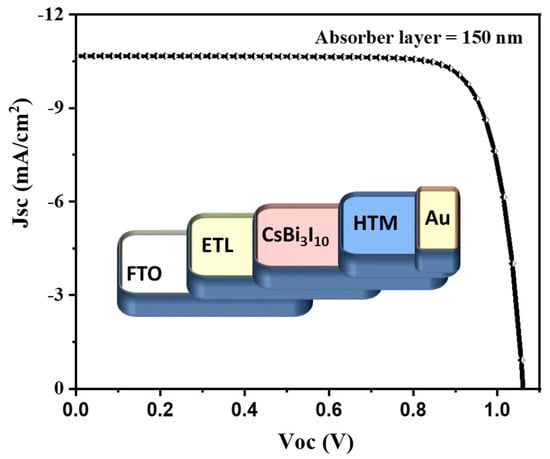
Figure 1.
J-V results for FTO (500 nm)/TiO2 (100 nm)/CBI (150 nm)/spiro-MeOTAD (150 nm)/Au. Inset shows device configuration.
3.2. Influence of Thickness of CBI Layer
The thickness of the CBI layer may significantly influence the photovoltaic parameters of the PVSKSCs. In this regard, different thicknesses of the CBI were used to optimize the photovoltaic performance of the CBI-based PVSKSCs. Thicknesses of 150 nm to 750 nm of CBI were used for further simulation studies, and the obtained J-V results are summarized in Figure 2a. It was seen that Voc (Figure 2b) and FF (Figure 2d) decrease with the increasing thickness of CBI, while Jsc (Figure 2c) increases with the increasing thickness of CBI. It is believed that the presence of more photon at a higher thickness of CBI may increase the Jsc value. The PCE of the proposed device configuration showed the highest PCE of 11.98% for 450 nm thick CBI layer-based PVSKSCs (Figure 2e).
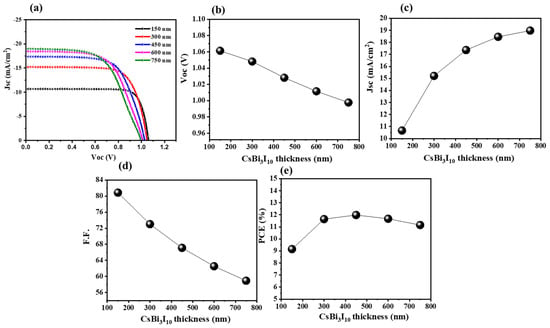
Figure 2.
(a) J-V curves and (b–e) photovoltaic parameters of the simulated device using different thicknesses of CBI.
The performance of the CBI-based PVSKSCs at different thickness of CBI are shown in Table 2.

Table 2.
Effect of thickness of the CBI absorber layer on photovoltaic parameters.
3.3. Effects of Different HTL
Due to the variation in the band alignment, band positions, and electronic properties of the HTL, the performance of the CBI-based PVSKSCs may be affected by tuning the HTL. In this regard, we have used different HTLs (spiro-OMeTAD, P3HT, Cu2O, and PTAA) for further simulation studies of CBI-based PVSKSCs. TiO2 was fixed as the ETL with a thickness of 100 nm, while the thickness of CBI was fixed as 450 nm. The thickness of the different HTLs was 150 nm. The obtained J-V results from the simulation software are summarized in Figure 3a. The extracted J-V parameters are displayed in Figure 3b–e. It can be seen that Cu2O shows a poor Voc but higher Jsc values for CBI-based PVSKSCs. In contrast, spiro-OMeTAD exhibits a higher Voc but the lowest Jsc value, as shown in Figure 3b and Figure 3c, respectively. However, the overall PCE of the spiro-OMeTAD-based PVSKSC cell was found to be the highest compared to the other HTLs, as shown in Table 3. This may be due to the better electronic properties or band alignments of the spiro-OMeTAD layer. Thus, we adopted spiro-OMeTAD as the optimized HTL for further simulation-based examination.
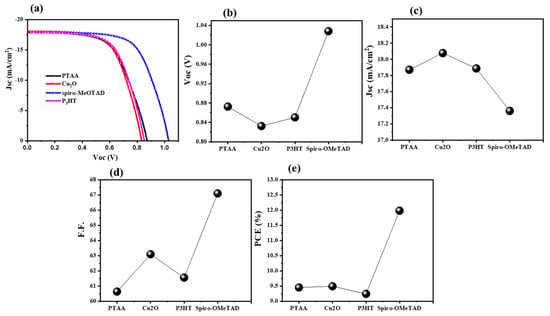
Figure 3.
(a) J-V curves and (b–e) photovoltaic parameters of the simulated device using different HTL layers.

Table 3.
Effects of different HTLs on the photovoltaic activity of CBI-based PVSKSCs.
3.4. Effects of Different ETLs
It is well known that the ETL plays vital role in the development of PVSKSCs. Thus, different ETLs have different band alignment, band positions, and electronic properties and the potential to affect the photovoltaic performance of CBI-based PVSKSCs. Therefore, it would be great significance to employ different ETLs for the simulation of CBI-based PVSKSCs. In further simulation experiments, we have adopted different ETLs (ZnSe, ZnO, SnO2, and TiO2) towards the simulation of CBI-based PVSKSCs. Spiro-OMeTAD with 150 nm thickness was fixed as the HTL, while thickness of the CBI was fixed at 450 nm. The simulated results were collected in the form of J-V graphs, which are compiled in Figure 4a. The Voc, Jsc, FF, and PCE of the CBI-based PVSKSCs with different ETLs are shown in Figure 4b, Figure 4c, Figure 4d, and Figure 4e, respectively. TiO2-based cells showed the highest Voc value and Jsc value, whereas SnO2-based cells exhibited the lowest Voc and Jsc value. The highest PCE of 11.98% was observed for TiO2-based PVSKSCs. This obtained PCE of 11.98% was higher compared to the PVSKSCs with other ETLs (Table 4). It is believed that the presence of desirable band positions and electronic properties may be the key points for this enhanced performance of CBI-based PVSKSCs.
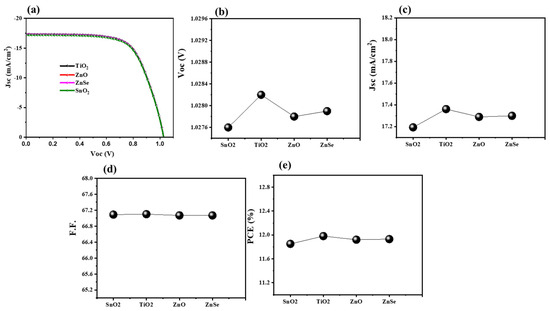
Figure 4.
(a) J-V curves and (b–e) photovoltaic parameters of the simulated device using different ETL layers.

Table 4.
Effects of different ETLs on the photovoltaic activity of CBI-based PVSKSCs.
3.5. Effects of Thickness of ETLs
The thickness of the ETL plays a significant role in achieving higher efficiencies. TiO2 was found to be a highly efficient and promising ETL for the development of CBI-based PVSKSCs. Thus, it is necessary to examine the influence of the TiO2 thickness on the photovoltaic performance of CBI-based PVSKSCs. For this purpose, we have fixed the thickness of CBI as 450 nm, whereas it is 150 nm for spiro-OMeTAD. The thickness of TiO2 was changed in the range of 100 nm to 300 nm. The simulated J-V graphs at different thicknesses of TiO2 are shown in Figure 5a.
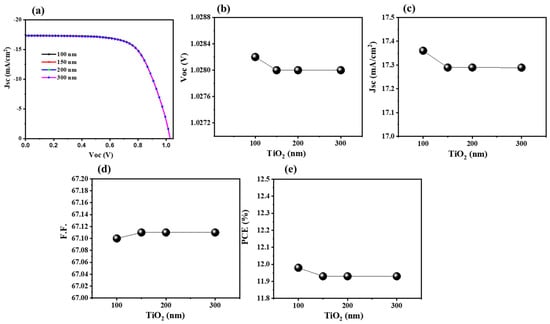
Figure 5.
(a) J-V curves and (b–e) photovoltaic parameters of the simulated device using different thicknesses of the TiO2 layer.
The photovoltaic parameters such as Voc, Jsc, FF, and PCE are displayed in Figure 5b, Figure 5c, Figure 5d, and Figure 5e, respectively. It can be seen that the PCE of the CBI-based PVSKSCs decreases with increasing thickness of the TiO2 layer from 100 nm to 300 nm (Table 5). Thus, it is suggested that a 100 nm thick TiO2 layer is the most promising and efficient thickness for CBI-based PVSKSCs. Therefore, it can be stated that the highest PCE of 11.98% was obtained for the device configuration of FTO (500 nm)/TiO2 (100 nm)/CBI (450 nm)/spiro-MeOTAD (150 nm)/Au.

Table 5.
Influence of thickness of TiO2 on photovoltaic activity of CBI-based PVSKSCs.
The band alignment of the different ETLs and HTLs with CBI are represented in Figure 6. It is suggested that the conduction band values of the ETLs are in good agreement, whereas the spiro-OMeTAD and P3HT HTLs were found to be more effective in terms of band alignments with CBI. CBI has a suitable conduction band value with different ETLs, whereas CBI has a good valence band value with different HTLs. The spiro-OMeTAD-based PVSKSCs showed the highest PCE compared to the other HTLs. This may be attributed to the well band alignment, conductivity, and hole mobility. However, more in-depth studies and experiments need to be carried out in the future to further improve the properties and performance of the CBI-based PVSKSCs.
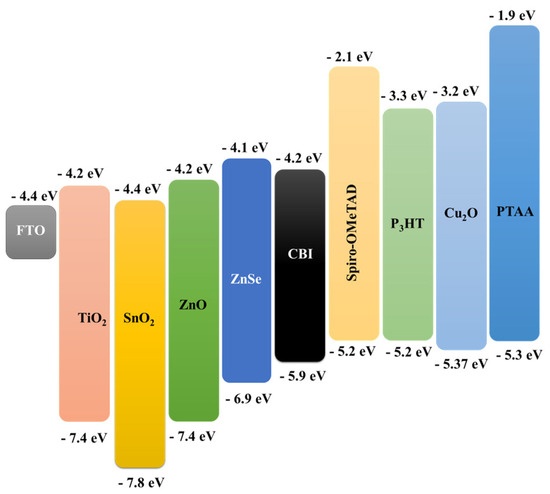
Figure 6.
Schematic representation of the band alignments of the absorber layer, different ETLs, and HTLs.
3.6. Comparison of the Photovoltaic Efficiency, Jsc, Voc, and FF of the Simulated PSCs with the Reported Literature
Previously, a large number of publications have reported the simulation of PVSKSCs. Various light absorber materials such as cesium tin iodide (CsSnI3), mixed lead–tin halide perovskite, formamidinium tin iodide (FASnI3), Cs2TiBr6, Cs2Sb2Br9, Cs2AgBiBr6, Cs2AgInCl3Br3, and CsGeI3, etc., have been used for the numerical simulation of PVSKSCs. The performance of the various absorber layer-based PVSKSCs are displayed in Table 6. It was observed that the reported articles on tin-based simulated cells show a decent performance for the development of lead-free PVSKSCs. The PCE of 11.98% obtained in the present study is compared with the reported articles in Table 6 [47,52,53,54,55,56,57,58,59,60,61]. It can be considered that the CBI-based simulated PVSKSCs displayed an acceptable performance.

Table 6.
Comparison of performance of CBI-based PVSKSCs with reported SCs having different absorber layers.
4. Conclusions
In this section, we conclude that a lead-free and air-stable perovskite-like material, i.e., CBI has been adopted as a light absorber material. CBI has a decent optical band gap and absorption coefficient, which suggests that CBI may be a promising energy material for PVSKSCs. In this work, we have used different thicknesses of CBI for simulation studies. The simulated results show that a 450 nm thick CBI film demonstrates better efficiency for PVSKSCs. Furthermore, different ETLs and HTLs were used for the optimization and finding of suitable ETLs and HTLs for PVSKSCs. TiO2 and spiro-OMeTAD were found to be suitable ETLs and HTLs, respectively. Subsequently, the thickness of the TiO2 layer was also optimized. The highest PCE of 11.98% was obtained for the simulation of CBI-based PVSKSCs under optimized conditions. We believe that the present study may be beneficial for researchers who are currently involved and trying hard to improve the efficiency of the CBI-based PVSKSCs in research laboratories.
Author Contributions
Conceptualization, S.A. and P.K.; methodology, S.A. and P.K.; supervision, R.A.K. and K.A.; software, P.K.; validation, R.A.K. and K.A.; formal analysis, S.A.; investigation, S.A.; writing—original draft preparation, S.A. and P.K.; writing—review and editing, K.A. and R.A.K. All authors have read and agreed to the published version of the manuscript.
Funding
Researchers Supporting Project (number RSP2025R400), King Saud University, Riyadh, Saudi Arabia.
Data Availability Statement
Data are available from the corresponding author on reasonable request.
Acknowledgments
The authors gratefully acknowledge the Researchers Supporting Project (number RSP2025R400), King Saud University, Riyadh, Saudi Arabia. K.A. gratefully thanks Marc Burgelman for SCAPS-1D software. P.K. acknowledges DST inspire, New Delhi, India.
Conflicts of Interest
The authors declare no conflicts of interest.
References
- Nate, S.; Bilan, Y.; Cherevatskyi, D.; Kharlamova, G.; Lyakh, O.; Wosiak, A. The Impact of Energy Consumption on the Three Pillars of Sustainable Development. Energies 2021, 14, 1372. [Google Scholar] [CrossRef]
- Chudy-Laskowska, K.; Pisula, T. An Analysis of the Use of Energy from Conventional Fossil Fuels and Green Renewable Energy in the Context of the European Union’s Planned Energy Transformation. Energies 2022, 15, 7369. [Google Scholar] [CrossRef]
- Reddy, V.J.; Hariram, N.P.; Ghazali, M.F.; Kumarasamy, S. Pathway to Sustainability: An Overview of Renewable Energy Integration in Building Systems. Sustainability 2024, 16, 638. [Google Scholar] [CrossRef]
- Azni, M.A.; Md Khalid, R.; Hasran, U.A.; Kamarudin, S.K. Review of the Effects of Fossil Fuels and the Need for a Hydrogen Fuel Cell Policy in Malaysia. Sustainability 2023, 15, 4033. [Google Scholar] [CrossRef]
- Halkos, G.; Gkampoura, E.-C. Assessing Fossil Fuels and Renewables’ Impact on Energy Poverty Conditions in Europe. Energies 2023, 16, 560. [Google Scholar] [CrossRef]
- Höök, M.; Tang, X. Depletion of fossil fuels and anthropogenic climate change—A review. Energy Policy 2013, 52, 797–809. [Google Scholar] [CrossRef]
- Bouhrim, H.; El Marjani, A.; Nechad, R.; Hajjout, I. Ocean Wave Energy Conversion: A Review. J. Mar. Sci. Eng. 2024, 12, 1922. [Google Scholar] [CrossRef]
- Itani, K.; De Bernardinis, A. Review on New-Generation Batteries Technologies: Trends and Future Directions. Energies 2023, 16, 7530. [Google Scholar] [CrossRef]
- Dash, S.K.; Chakraborty, S.; Elangovan, D. A Brief Review of Hydrogen Production Methods and Their Challenges. Energies 2023, 16, 1141. [Google Scholar] [CrossRef]
- Akinyele, D.; Olabode, E.; Amole, A. Review of Fuel Cell Technologies and Applications for Sustainable Microgrid Systems. Inventions 2020, 5, 42. [Google Scholar] [CrossRef]
- Dragonetti, C.; Colombo, A. Recent Advances in Dye-Sensitized Solar Cells. Molecules 2021, 26, 2461. [Google Scholar] [CrossRef] [PubMed]
- Lin, Y.-S.; Chen, W.-H. Dye-Sensitized Solar Cells with Modified TiO2 Scattering Layer Produced by Hydrothermal Method. Materials 2025, 18, 278. [Google Scholar] [CrossRef]
- Li, Y.; Huang, W.; Zhao, D.; Wang, L.; Jiao, Z.; Huang, Q.; Wang, P.; Sun, M.; Yuan, G. Recent Progress in Organic Solar Cells: A Review on Materials from Acceptor to Donor. Molecules 2022, 27, 1800. [Google Scholar] [CrossRef]
- Gnida, P.; Amin, M.F.; Pająk, A.K.; Jarząbek, B. Polymers in High-Efficiency Solar Cells: The Latest Reports. Polymers 2022, 14, 1946. [Google Scholar] [CrossRef]
- Ašmontas, S.; Mujahid, M. Recent Progress in Perovskite Tandem Solar Cells. Nanomaterials 2023, 13, 1886. [Google Scholar] [CrossRef]
- Afre, R.A.; Pugliese, D. Perovskite Solar Cells: A Review of the Latest Advances in Materials, Fabrication Techniques, and Stability Enhancement Strategies. Micromachines 2024, 15, 192. [Google Scholar] [CrossRef] [PubMed]
- Iftikhar, H.; Sonai, G.G.; Hashmi, S.G.; Nogueira, A.F.; Lund, P.D. Progress on Electrolytes Development in Dye-Sensitized Solar Cells. Materials 2019, 12, 1998. [Google Scholar] [CrossRef]
- Gnida, P.; Schab-Balcerzak, E. Effect of Structural and Material Modifications of Dye-Sensitized Solar Cells on Photovoltaic Performance. Coatings 2024, 14, 837. [Google Scholar] [CrossRef]
- Chen, Y.; Zhang, M.; Li, F.; Yang, Z. Recent Progress in Perovskite Solar Cells: Status and Future. Coatings 2023, 13, 644. [Google Scholar] [CrossRef]
- Khalid, M.; Mallick, T.K. Stability and Performance Enhancement of Perovskite Solar Cells: A Review. Energies 2023, 16, 4031. [Google Scholar] [CrossRef]
- Chiang, S.-E.; Ke, Q.-B.; Chandel, A.; Cheng, H.-M.; Yen, Y.-S.; Shen, J.-L.; Chang, S.H. 19% Efficient P3CT-Na Based MAPbI3 Solar Cells with a Simple Double-Filtering Process. Polymers 2021, 13, 886. [Google Scholar] [CrossRef]
- Liu, C.; Hu, M.; Zhou, X.; Wu, J.; Zhang, L.; Kong, W.; Li, X.; Zhao, X.; Dai, S.; Xu, B.; et al. Efficiency and stability enhancement of perovskite solar cells by introducing CsPbI3 quantum dots as an interface engineering layer. NPG Asia Mater. 2018, 10, 552–561. [Google Scholar] [CrossRef]
- Nguyen, H.; Penukula, S.; Mahaffey, M.; Rolston, N. All inorganic CsPbI3 perovskite solar cells with reduced mobile ion concentration and film stress. MRS Commun. 2024, 14, 208–214. [Google Scholar] [CrossRef]
- Yang, T.; Gao, L.; Lu, J.; Ma, C.; Du, Y.; Wang, P.; Ding, Z.; Wang, S.; Xu, P.; Liu, D.; et al. One-stone-for-two-birds strategy to attain beyond 25% perovskite solar cells. Nat. Commun. 2023, 14, 839. [Google Scholar] [CrossRef] [PubMed]
- Kopacic, I.; Friesenbichler, B.; Hoefler, S.F.; Kunert, B.; Plank, H.; Rath, T.; Trimmel, G. Enhanced Performance of Germanium Halide Perovskite Solar Cells through Compositional Engineering. ACS Appl. Energy Mater. 2018, 1, 343–347. [Google Scholar] [CrossRef]
- Chen, K.; Wu, P.; Yang, W.; Su, R.; Luo, D.; Yang, X.; Tu, Y.; Zhu, R.; Gong, Q. Low-dimensional perovskite interlayer for highly efficient lead-free formamidinium tin iodide perovskite solar cells. Nano Energy 2018, 49, 411–418. [Google Scholar] [CrossRef]
- Pitaro, M.; Tekelenburg, E.K.; Shao, S.; Loi, M.A. Tin Halide Perovskites: From Fundamental Properties to Solar Cells. Adv. Mater. 2022, 34, 2105844. [Google Scholar] [CrossRef] [PubMed]
- Azhari, A.W.; Then, F.S.X.; Halin, D.S.C.; Sepeai, S.; Ludin, N.A. Tin and germanium substitution in lead free perovskite solar cell: Current status and future trends. IOP Conf. Ser. Mater. Sci. Eng. 2020, 957, 012057. [Google Scholar] [CrossRef]
- Ahmad, K.; Kumar, P.; Kim, H. Recent Progress in Lead Free Tin-Halide Perovskite Materials Based Solar Cells via SCAPS Based Numerical Simulation. ChemistrySelect 2024, 9, e202402044. [Google Scholar] [CrossRef]
- Kumar, P.; Khan, M.Q.; Shabbir, M.; Ahmad, K.; Oh, T. Improving Germanium Halide Perovskite Solar Cells: Insights from SCAPS Simulation Analysis Compared to Experimental Data. ChemistrySelect 2024, 9, e202403381. [Google Scholar] [CrossRef]
- Ahmad, K.; Kumar, P.; Khan, M.Q.; Alsulmi, A.; Kim, H. Improved Stability of CsBi3I10 Based Pb-Free Perovskite Solar Cells. ChemistrySelect 2023, 8, e202300520. [Google Scholar] [CrossRef]
- Ahmad, K.; Mobin, S.M. Recent Progress and Challenges in A3Sb2X9-Based Perovskite Solar Cells. ACS Omega 2020, 5, 28404–28412. [Google Scholar] [CrossRef]
- Ahmad, K.; Ansari, S.N.; Natarajan, K.; Mobin, S.M. A (CH3NH3)3Bi2I9 Perovskite Based on a Two-Step Deposition Method: Lead-Free, Highly Stable, and with Enhanced Photovoltaic Performance. ChemElectroChem 2019, 6, 1192–1198. [Google Scholar] [CrossRef]
- Ahmad, K.; Ansari, S.N.; Natarajan, K.; Mobin, S.M. Design and Synthesis of 1D-Polymeric Chain Based [(CH3NH3)3Bi2Cl9]n Perovskite: A New Light Absorber Material for Lead Free Perovskite Solar Cells. ACS Appl. Energy Mater. 2018, 1, 2405–2409. [Google Scholar] [CrossRef]
- Liang, G.-X.; Chen, X.-Y.; Chen, Z.-H.; Lan, H.-B.; Zheng, Z.-H.; Fan, P.; Tian, X.-Q.; Duan, J.-Y.; Wei, Y.-D.; Su, Z.-H. Inorganic and Pb-Free CsBi3I10 Thin Film for Photovoltaic Applications. J. Phys. Chem. C 2019, 123, 27423–27428. [Google Scholar] [CrossRef]
- Mariyappan, P.; Chowdhury, T.H.; Subashchandran, S.; Bedja, I.; Ghaithan, H.M.; Islam, A. Fabrication of lead-free CsBi3I10 based compact perovskite thin films by employing solvent engineering and anti-solvent treatment techniques: An efficient photo-conversion efficiency up to 740 nm. Sustain. Energy Fuels 2020, 4, 5042–5049. [Google Scholar] [CrossRef]
- Lan, H.; Chen, X.; Fan, P.; Liang, G. Inorganic and lead-free CsBi3I10 thin-film solar cell prepared by single-source thermal evaporation. J. Mater. Sci. Mater. Electron. 2021, 32, 11183–11192. [Google Scholar] [CrossRef]
- Kang, J.; Liu, J.; Allen, O.; Al-Mamun, M.; Liu, P.; Yin, H.; Wang, Y.; Chen, S.; Zhao, H. Fabrication of High-Quality CsBi3I10 Films via a Gas-Assisted Approach for Efficient Lead-Free Perovskite Solar Cells. Energy Technol. 2022, 10, 2200318. [Google Scholar] [CrossRef]
- Vijaya, S.; Subbiah, J.; Jones, D.J.; Anandan, S. LARP-assisted synthesis of CsBi3I10 perovskite for efficient lead-free solar cells. RSC Adv. 2023, 13, 9978–9982. [Google Scholar] [CrossRef] [PubMed]
- Kumar, A.; Kumar, A.; Tamboli, M.S.; Ubaidullah, M.; Jayarubi, J.; Tripathi, S.K. A modified drop-casting technique for efficient lead-free, environment-friendly thin film CsBi3I10 perovskite solar cells. Phys. B Condens. Matter 2024, 672, 415426. [Google Scholar] [CrossRef]
- Johansson, M.B.; Zhu, H.; Johansson, E.M.J. Extended Photo-Conversion Spectrum in Low-Toxic Bismuth Halide Perovskite Solar Cells. J. Phys. Chem. Lett. 2016, 7, 3467–3471. [Google Scholar] [CrossRef]
- Masawa, S.M.; Zhao, C.; Liu, J.; Xu, J.; Yao, J. Fabrication and Characterization of a Lead-Free Cesium Bismuth Iodide Perovskite through Antisolvent-Assisted Crystallization. Nanomaterials 2024, 14, 626. [Google Scholar] [CrossRef] [PubMed]
- Son, C.; Son, H.; Jeong, B.-S. Enhanced Conversion Efficiency in MAPbI3 Perovskite Solar Cells through Parameters Optimization via SCAPS-1D Simulation. Appl. Sci. 2024, 14, 2390. [Google Scholar] [CrossRef]
- Pinzón, C.; Martínez, N.; Casas, G.; Alvira, F.C.; Denon, N.; Brusasco, G.; Medina Chanduví, H.; Gil Rebaza, A.V.; Cappelletti, M.A. Optimization of Inverted All-Inorganic CsPbI3 and CsPbI2Br Perovskite Solar Cells by SCAPS-1D Simulation. Solar 2022, 2, 559–571. [Google Scholar] [CrossRef]
- Burgelman, M.; Nollet, P.; Degrave, S. Modelling polycrystalline semiconductor solar cells. Thin Solid Films 2000, 361–362, 527–532. [Google Scholar] [CrossRef]
- Tara, A.; Bharti, V.; Sharma, S.; Gupta, R. Device simulation of FASnI3 based perovskite solar cell with Zn(O0.3, S0.7) as electron transport layer using SCAPS-1D. Opt. Mater. 2021, 119, 111362. [Google Scholar] [CrossRef]
- Mohandes, A.; Moradi, M.; Nadgaran, H. Numerical simulation of inorganic Cs2AgBiBr6 as a lead-free perovskite using device simulation SCAPS-1D. Opt. Quant. Electron. 2021, 53, 319. [Google Scholar] [CrossRef]
- Singh, A.; Agarwal, A.; Agarwal, M. Performance evaluation of lead–free double-perovskite solar cell. Opt. Mater. 2021, 114, 110964. [Google Scholar] [CrossRef]
- Ahmmed, S.; Karim, M.A.; Rahman, M.H.; Aktar, A.; Islam, M.R.; Islam, A.; Ismail, A.B.M. Performance analysis of lead-free CsBi3I10-based perovskite solar cell through the numerical calculation. Sol. Energy 2021, 226, 54–63. [Google Scholar] [CrossRef]
- Hossain, M.I.; Alharbi, F.H.; Tabet, N. Copper oxide as inorganic hole transport material for lead halide perovskite based solar cells. Sol. Energy 2015, 120, 370–380. [Google Scholar] [CrossRef]
- Singh, A.K.; Srivastava, S.; Mahapatra, A.; Baral, J.K.; Pradhan, B. Performance optimization of lead free-MASnI3 based solar cell with 27% efficiency by numerical simulation. Opt. Mater. 2021, 117, 111193. [Google Scholar] [CrossRef]
- Danladi, E.; Obagboye, L.F.; Aisida, S.; Ezema, F.I.; Okorie, O.; Bwamba, J.A.; Emmanuel, P.A.; Hussaini, A.A.; Jubu, P.R.; Ozurumba, A.C. 20.730% highly efficient lead-free CsSnI3-based perovskite solar cells with various charge transport materials: A SCAPS-1D study. Multiscale and Multidiscip. Model. Exp. Des. 2025, 8, 114. [Google Scholar] [CrossRef]
- Wang, A.; Gan, X.; Yu, J. Simulation of narrow-bandgap mixed Pb–Sn perovskite solar cells with inverted p-i-n structure. Opt. Mater. 2021, 112, 110751. [Google Scholar] [CrossRef]
- Ahmed, S.; Jannat, F.; Khan, A.K.; Alim, M.A. Numerical development of eco-friendly Cs2TiBr6 based perovskite solar cell with all-inorganic charge transport materials via SCAPS-1D. Optik 2021, 225, 165765. [Google Scholar] [CrossRef]
- Sachchidanand; Garg, V.; Kumar, A.; Sharma, P. Numerical simulation of novel lead-free Cs3Sb2Br9 absorber-based highly efficient perovskite solar cell. Opt. Mater. 2021, 122, 111715. [Google Scholar] [CrossRef]
- Bareth, B.K.; Tripathi, M.N.; Maravi, R. High photovoltaic performance of lead-free Cs2AgInCl6-xBrx perovskite solar cell using DFT and SCAPS-1D simulations. Mater. Today Commun. 2024, 39, 108618. [Google Scholar] [CrossRef]
- Samanta, M.; Ahmed, S.I.; Chattopadhyay, K.K.; Bose, C. Role of various transport layer and electrode materials in enhancing performance of stable environment-friendly Cs2TiBr6 solar cell. Optik 2020, 217, 164805. [Google Scholar] [CrossRef]
- Alam, I.; Mollick, R.; Ashraf, M.A. Numerical simulation of Cs2AgBiBr6-based perovskite solar cell with ZnO nanorod and P3HT as the charge transport layers. Phys. B Condens. Matter 2021, 618, 413187. [Google Scholar] [CrossRef]
- Zhang, Y.; Meng, X.; Liu, X.; Zhou, F.; Yang, W.; Fan, Y.; He, P.; Wu, J.; Wang, H.; Cheng, Y. SCAPS simulation and DFT study of lead-free perovskite solar cells based on CsGeI3. Mater. Chem. Phys. 2023, 306, 128084. [Google Scholar] [CrossRef]
- Manjunath, V.; Reddy, Y.K.; Bimli, S.; Choudhary, R.J.; Devan, R.S. 22% efficient Kusachiite solar cells of CuBi2O4 light harvester and ABO3 buffer layers: A theoretical analysis. Mater. Today Commun. 2022, 32, 104061. [Google Scholar] [CrossRef]
- Raj, A.; Kumar, M.; Kumar, A.; Singh, K.; Sharma, S.; Singh, R.C.; Pawar, M.S.; Yahya, M.Z.A.; Anshul, A. Comparative analysis of ‘La’ modified BiFeO3-based perovskite solar cell devices for high conversion efficiency. Ceram. Int. 2023, 49, 1317–1327. [Google Scholar] [CrossRef]
Disclaimer/Publisher’s Note: The statements, opinions and data contained in all publications are solely those of the individual author(s) and contributor(s) and not of MDPI and/or the editor(s). MDPI and/or the editor(s) disclaim responsibility for any injury to people or property resulting from any ideas, methods, instructions or products referred to in the content. |
© 2025 by the authors. Licensee MDPI, Basel, Switzerland. This article is an open access article distributed under the terms and conditions of the Creative Commons Attribution (CC BY) license (https://creativecommons.org/licenses/by/4.0/).